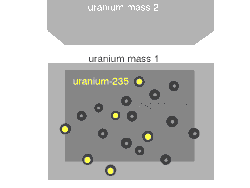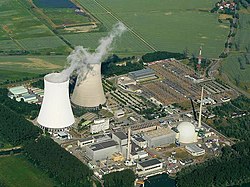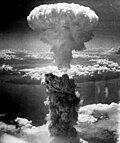Nuclear fission
Nuclear fission is a kind of nuclear reaction. It is when an atom splits apart into smaller atoms. Some fission reactions give off a lot of energy, and are used in nuclear weapons and nuclear reactors. Nuclear fission was discovered in December 1938 by physicists Lise Meitner and Otto Frisch, who observed a uranium nucleus splitting in two. Although they originally thought the two tiny resulting nuclei were barium isotopes, what Meitner and Frisch truly saw was a process that would revolutionize nuclear chemistry: nuclear fission.[1]
An atom is the smallest particle which makes up a chemical element (e.g. hydrogen, oxygen, magnesium). All atoms are very small. Atoms are made of three components or particles: Protons, neutrons and electrons. The protons and neutrons are clumped together in a ball called a nucleus, at the center of every atom. The electrons orbit around the nucleus in its 'electron cloud'. Elements which have large nuclei, such as uranium and plutonium, can be made to fission.
If a (relatively) very large atomic nucleus is hit by a slow-moving neutron, it will sometimes become unstable and break into two nuclei. When the nucleus breaks apart (or fissions) it releases energy, mostly as gamma rays and heat. It also causes some neutrons to be released from the nucleus.
This reaction can occur "spontaneously" if the original nucleus is highly unstable. The resulting products are radioactive isotopes, but do not release enough energy to generate usable power or make a bomb due to the lack of a chain reaction.[2] It can also be induced by a neutron.
For a few isotopes (an atom with the same amount of protons but a different amount of neutrons) such fission can release many neutrons. If those neutrons then hit other atoms, they will make the other atoms split. This can happen again and again. This is called a nuclear chain-reaction, and it can release huge amounts of energy. Nuclear chain-reactions occur most commonly with Uranium-235. The splitting of Uranium-235 is started when a neutron is slammed into its positively charged nucleus. This results in two lighter isotopes (such as Barium-141 and Krypton-92), whose total mass is less than that of the original Uranium isotope. The "mass defect" is converted into various forms of energy. A neutron is also released, triggering the chain reaction as each additional neutron causes further collisions with existing Uranium isotopes.[3]
In a nuclear bomb, the chain reaction must happen very quickly to make a very big explosion. The amount of energy released in the explosion is measured in kilotons. One kiloton is the same as the energy of one thousand tons of trinitrotoluene.
In a nuclear reactor this must happen slowly to make heat. The heat is used to boil water into steam, which turns a steam turbine to generate electricity.
Nuclear Fission Media
A visual representation of an induced nuclear fission event where a slow-moving neutron is absorbed by the nucleus of a uranium-235 atom, which fissions into two fast-moving lighter elements (fission products) and additional neutrons. Most of the energy released is in the form of the kinetic velocities of the fission products and the neutrons.
Fission product yields by mass for thermal neutron fission of uranium-235, plutonium-239, a combination of the two typical of current nuclear power reactors, and uranium-233, used in the thorium cycle
Animation of a Coulomb explosion in the case of a cluster of positively charged nuclei, akin to a cluster of fission fragments. Hue level of color is proportional to (larger) nuclei charge. Electrons (smaller) on this time-scale are seen only stroboscopically and the hue level is their kinetic energy.
The cooling towers of the Philippsburg Nuclear Power Plant in Germany
The mushroom cloud of the atomic bomb dropped on Nagasaki, Japan, on 9 August 1945 rose over 12 kilometres (7.5 mi) above the bomb's hypocenter. An estimated 39,000 people were killed by the atomic bomb, of whom 23,145–28,113 were Japanese factory workers, 2,000 were Korean slave laborers, and 150 were Japanese combatants.
Otto Hahn and Lise Meitner in 1912
References
- ↑ "December 1938: Lise Meitner & Otto Frisch discover nuclear fission". www.aps.org. Retrieved 2023-04-07.
- ↑ "Manhattan Project: Science > Nuclear Physics > FISSION". www.osti.gov. Retrieved 2023-04-07.
- ↑ "Fission and Fusion". Chemistry LibreTexts. 2013-10-02. Retrieved 2023-04-07.
Other websites
![]() Media related to Nuclear fission at Wikimedia Commons
Media related to Nuclear fission at Wikimedia Commons







